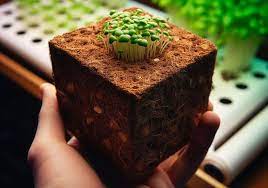
Blog
Hydroponic Growing with Coco Peat
Hydroponic Growing with Coco Peat: An Efficient Solution
Hydroponic growing with coco peat is becoming an increasingly popular method for cultivating plants without the use of traditional soil. This innovative approach has gained significant attention due to its efficiency, sustainability, and ability to produce healthy crops in a variety of settings. By replacing soil with coco peat, an organic, renewable material, hydroponic systems can offer numerous benefits for both small-scale gardeners and large-scale commercial growers.


What is Hydroponic Growing with Coco Peat?
Hydroponic growing with coco peat refers to the use of coco peat (also known as coir) as a growing medium in hydroponic systems. Coco peat is a natural fiber extracted from the husk of coconuts and is often used as a soil substitute due to its excellent water retention properties, aeration, and ability to provide essential nutrients to plants.
In hydroponic systems, plants are grown without soil, and instead, a nutrient-rich water solution is used to deliver the necessary nutrients directly to the plant roots. The coco peat acts as a support structure for the roots, ensuring they have access to the water and nutrients needed for healthy growth. This method of hydroponic growing with coco peat allows for precise control over water and nutrient levels, leading to more efficient plant growth and higher yields.
Benefits of Hydroponic Growing with Coco Peat
The use of coco peat in hydroponic growing systems offers a variety of advantages for both hobbyists and commercial growers. Some of the key benefits include:
1. Excellent Water Retention and Drainage
One of the primary reasons for choosing coco peat in hydroponic systems is its ability to retain water while also allowing for proper drainage. This ensures that the plant roots receive a consistent supply of water, reducing the risk of overwatering or underwatering. Proper water management is crucial in hydroponic systems, and coco peat helps maintain the ideal moisture levels for plant roots.
2. Eco-Friendly and Sustainable
Coco peat is an eco-friendly alternative to traditional growing mediums, as it is made from a renewable resource: coconut husks. Unlike peat moss, which is harvested from environmentally sensitive areas and takes centuries to regenerate, coco peat is a byproduct of the coconut industry, making it a sustainable choice. Additionally, coco peat is biodegradable and can be composted or reused, reducing waste in the environment.
3. Better Root Development
The porous nature of coco peat provides excellent aeration for plant roots, allowing them to breathe and grow more vigorously. This helps prevent root rot, a common issue in traditional soil-based growing systems. With proper oxygen flow and nutrient availability, plants grown with coco peat in hydroponic systems tend to develop stronger, healthier roots, leading to more robust plant growth and higher yields.
4. Disease-Free Growing Medium
Unlike soil, which can harbor harmful pathogens, pests, and diseases, coco peat provides a sterile environment for plants. This reduces the risk of soil-borne diseases, such as root rot and fungal infections, which can negatively impact plant health. By using coco peat in hydroponic systems, growers can minimize the need for chemical pesticides and fertilizers, resulting in cleaner, healthier crops.
5. Versatility and Easy to Use
Coco peat is a highly versatile growing medium that can be used in a variety of hydroponic systems, including wick, deep water culture (DWC), and nutrient film technique (NFT) systems. It can also be easily manipulated into different forms, such as blocks, bricks, or loose pellets, to fit various hydroponic setups. The ease of use and adaptability of coco peat make it an ideal choice for both beginners and experienced growers.
How to Use Coco Peat in Hydroponic Systems
Using coco peat in hydroponic growing systems is relatively straightforward. Here are the basic steps for incorporating coco peat into your hydroponic setup:
1. Preparing the Coco Peat
Before using coco peat, it must be rehydrated if it comes in a compressed form, such as blocks or bricks. Simply soak the coco peat in water until it expands and becomes loose and fluffy. Be sure to rinse the coco peat to remove any excess salts or impurities that may be present.
2. Setting Up the Hydroponic System
Once the coco peat is prepared, it can be placed in your hydroponic system, whether it is a simple tray, a vertical tower, or a more complex system like deep water culture. The coco peat should be placed in containers or trays with adequate drainage to prevent water from stagnating around the plant roots.
3. Adding Nutrient Solution
In hydroponic systems, plants rely on a nutrient solution rather than soil to receive the necessary minerals for growth. The nutrient solution should be carefully balanced to provide the correct ratio of nitrogen, phosphorus, potassium, and other essential nutrients. Coco peat will hold the nutrients within its fibers, ensuring that the plants can access them as needed.
4. Monitoring Plant Growth
After setting up the system, it is important to monitor the plants regularly to ensure they are receiving adequate water, nutrients, and light. Adjust the nutrient solution and water levels as needed, and ensure the plants are getting enough exposure to sunlight or artificial grow lights.
Conclusion
Hydroponic growing with coco peat is an innovative and sustainable solution for cultivating plants in a soil-free environment. Its ability to retain water, provide proper aeration, and promote healthy root growth makes it an ideal growing medium for hydroponic systems. Additionally, its eco-friendly properties and versatility make it a top choice for both home gardeners and commercial growers.
